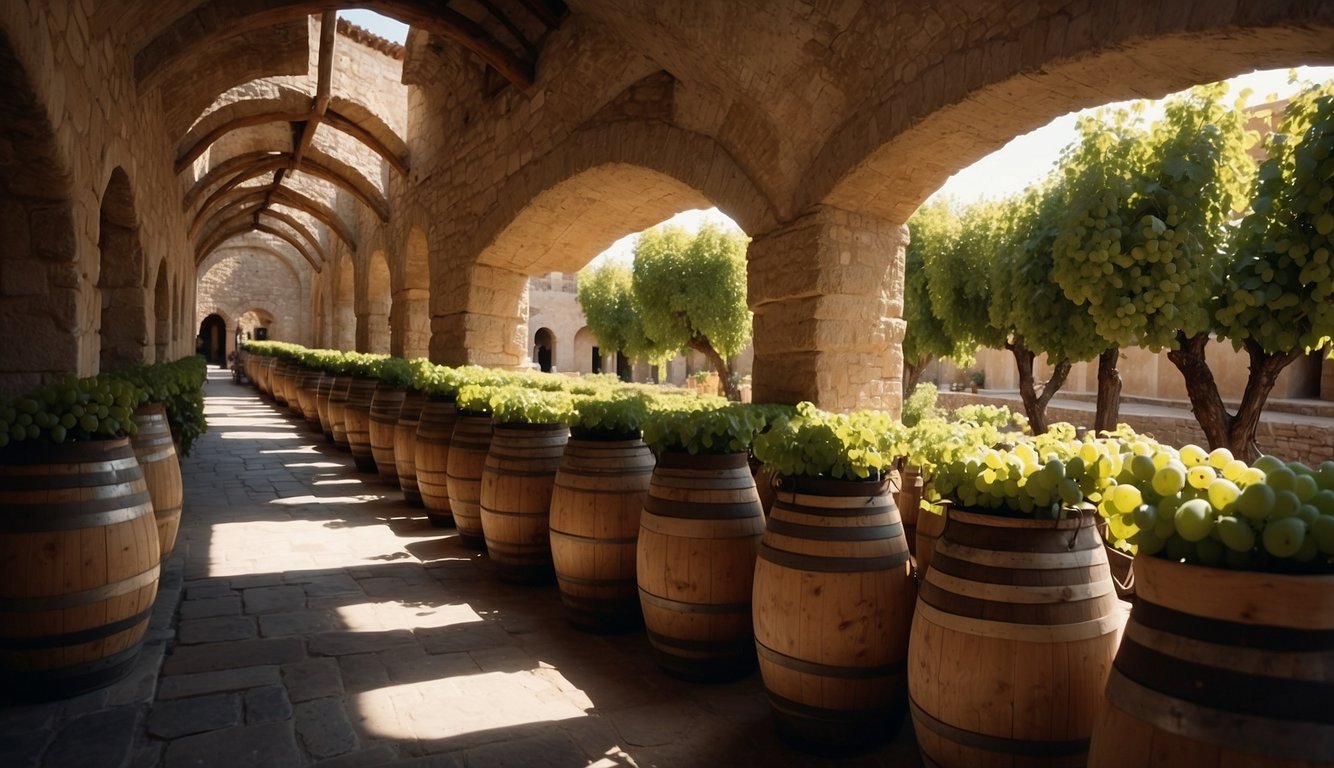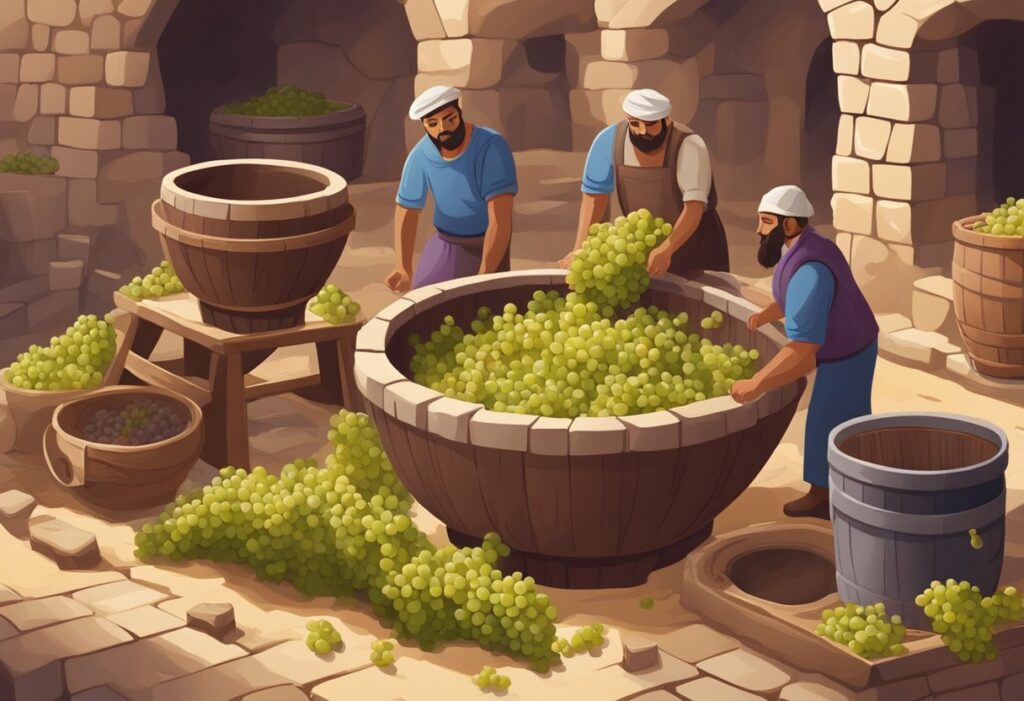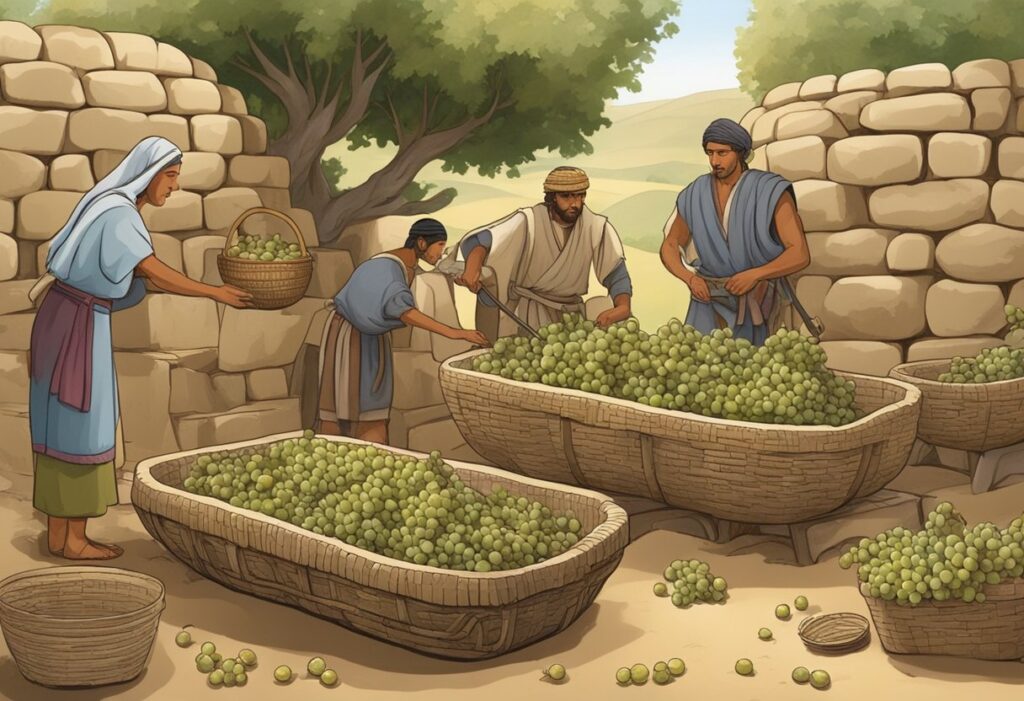Wine played a central role in both Ancient Greek and Roman societies, shaping their cultures and daily lives in profound ways. In Ancient Greece, wine was more than just a drink; it was a cornerstone of social and religious activities. You’d often find Greeks at symposiums, where wine-fueled discussions and debates took center stage. The Greeks even believed that drinking undiluted wine was barbaric, preferring to mix it with water to create a gentler drink. Learn more about this cultural practice here.

In Roman society, wine was just as significant, if not more so. Romans admired Greek wines and eventually developed their own sophisticated wine culture. Vineyards in certain areas were famed for their exceptional quality, a concept known as “terroir.” This appreciation for wine quality laid the groundwork for modern wine connoisseurship. You can explore how Romans integrated wine into all levels of their society here.
Intriguingly, wine was not reserved for the elite. It was an everyday drink accessible to both the wealthy and the poor, making it an essential part of daily life. The widespread consumption of wine helped to forge connections within and between these ancient cultures, influencing trade and communal rituals. Dive deeper into the history of wine in these ancient societies here.
Historical Significance
Wine played a crucial role in both Ancient Greek and Roman societies. It was not just a drink but part of daily life, cultural rituals, and trade.
Wine in Ancient Greek Culture
Wine in Ancient Greece was more than a mere beverage. It was integral to social gatherings known as symposia. These were parties where philosophers, poets, and politicians would discuss ideas while drinking wine.
The Greeks believed that their god Dionysus was the patron of wine. Viticulture, the cultivation of grapevines, became a critical part of Greek agriculture. They developed advanced techniques in winemaking and even aged wines in clay amphorae.
Additionally, wine was essential in trade. Greek wine reached as far as Egypt and the Black Sea. The spread of wine culture through Greek colonies helped embed it deeply in Mediterranean societies.
Roman Society and Wine
In the Roman Empire, wine was ubiquitous. Everyone, from the wealthy elite to the poor, consumed it. Romans celebrated wine in their convivia or feasts, marking it as a symbol of status and pleasure.
The Romans made viticulture a science, developing specific techniques to improve grape cultivation and wine production. They identified diverse terroirs to determine where the best wines could be produced, a concept still relevant today.
Wine was also tied to religion. Festivals like the Bacchanalia honored the god Bacchus, the Roman equivalent of Dionysus. These events were lavish, filled with wine and revelry, highlighting its cultural significance.
Influence of Phoenicians and Trade
The Phoenicians were pivotal in spreading wine culture. As skilled sailors and traders, they connected the Mediterranean with their vast network. They introduced grapevine cultivation to new regions, such as North Africa and Southern Spain.
Trade routes established by the Phoenicians allowed for the widespread distribution of wine. They exchanged it for other valuable goods, making it a staple for economic growth.
Phoenician amphorae found across sites like Carthage and Cyprus indicate how crucial wine was in trade. Their influence helped transform local economies and integrate wine into the cultural practices of various ancient societies.
By incorporating techniques and varieties learned from the Phoenicians, both Greeks and Romans expanded their wine cultures, making it a lasting symbol of their civilizations.
Cultivation and Production
Wine held a significant place in ancient Greek and Roman societies, and understanding how it was cultivated and produced offers insight into its importance. This section covers the methods used in viticulture and the technological advancements in winemaking during that era.
Viticulture in the Mediterranean
Vineyards flourished in the Mediterranean due to the region’s ideal climate and soil. The Greeks and Romans carefully selected prime locations, ensuring the soil was rich and well-drained. These conditions were ideal for growing grapevines, which thrived in hot, dry summers and mild, wet winters.
Grape cultivation reached Greece by the end of the 3rd millennium BCE and Italy by the beginning of the 1st millennium BCE. By the 8th century BCE, viticulture had expanded, embedding wine deep into everyday life. Greeks institutionalized wine-drinking with practices like symposia, while the Romans improved and spread viticulture throughout their empire.
Winemaking Techniques and Technology
Ancient winemaking techniques were advanced for their time. The Greeks and Romans both used treading to extract juice from grapes, followed by fermentation in large vats. They added a wide array of flavors, including herbs, spices, and even seawater, to enhance the taste.
Romans often used terra-cotta containers, known as amphorae, for storage and aging, improving the wine’s quality. They also developed mechanical presses to increase efficiency. This technology resulted in a variety of wines, some sweetened with honey or pine resin.
Their innovations in viticulture and winemaking did more than produce drinks; they shaped social customs and trade in the Mediterranean, influencing regions far beyond their borders.
Social and Cultural Practices

Wine played a crucial role in the daily and ceremonial life of ancient Greek and Roman societies. It influenced their diet, health practices, and social gatherings.
Dionysus: God of Wine
In ancient Greece, Dionysus was revered as the god of wine, fertility, and festivity. His association with wine made him one of the most popular deities. Celebrations in his honor, known as Dionysia, were filled with music, dance, and theatrical performances.
These festivals were crucial for community bonding and cultural expression. People would gather to rejoice and worship, strengthening social ties. The cult of Dionysus also spread to Rome, where he was known as Bacchus, influencing Roman festivals and cultural practices.
Symposiums and Social Gatherings
Ancient Greeks institutionalized wine-drinking in exclusive gatherings called symposiums. These were male-only events where wine was diluted with water and consumed while engaging in intellectual discussions and entertainment.
The symposium created a space for social interaction and philosophical debates. The host, known as the symposiarch, had the duty of deciding the wine-to-water ratio and keeping the gathering orderly. In Rome, similar gatherings called convivia were popular, where wine and discussions also played significant roles, fostering social unity.
Wine in Ancient Diets and Health
Wine was more than just a social beverage; it was an essential part of the diet in Greece and Rome. Greeks often mixed it with water and consumed it daily. It was considered healthier than drinking water alone due to water contamination issues.
In the context of health, wine was used for its medicinal properties. It was believed to aid digestion, serve as an antiseptic, and provide a calming effect. Roman physicians, like Galen, often prescribed wine as a treatment for various ailments, further embedding it into daily life and health practices.
Wine culture in the Hellenistic Mediterranean shows the depth of these practices.*”
Economic Impact

Wine played a significant role in shaping economic activities in Ancient Greece and Rome. It influenced trade routes and formed a substantial part of the economy through its production and distribution.
Trade Routes and Wine Trade
Wine became a valuable commodity in ancient trade. The Greeks and Romans established extensive trade routes to transport wine across the Mediterranean. These routes stretched from the Black Sea to the Iberian Peninsula.
The demand for wine facilitated the development of new maritime routes. Merchants sailed from port to port, ensuring that cities had ample supply. This trade also helped spread Greek and Roman culture along with their wines. The movement of goods, including wine, contributed to economic prosperity and cultural exchange.
The Economy of Wine in Antiquity
Wine production influenced the economy by promoting agricultural practices and employment. The cultivation of vines and grapes provided jobs for many individuals, from farmers to winemakers. The emphasis on viticulture led to advancements in agricultural techniques.
Wine was a staple in both common and elite diets, contributing to its high economic value. Cities levied taxes on the wine trade, generating revenue. The exchange of wine for other goods and services also strengthened economic ties between regions.
The economic impact of wine extended beyond local markets. Exporting wine created economic interdependencies, with regions specializing in different aspects of wine production and trade. The interconnectedness of these activities highlights the pivotal role wine played in the ancient economy.
Archaeological Insights

Discoveries of ancient wineries and amphorae reveal how wine was produced, stored, and transported in ancient Greek and Roman societies. This sheds light on the economic and social roles of wine.
Discovering Ancient Wineries
Archaeologists have unveiled numerous ancient wineries in regions like Pompeii and Crete. These sites provide a window into the winemaking techniques used thousands of years ago.
For example, excavation of a winery in Pompeii shows evidence of grape pressing and fermentation tanks, highlighting how wine production was deeply embedded in daily life. In Crete, the discovery of ancient vineyards and wine presses suggests a longstanding tradition of viticulture dating back to the Minoan civilization.
These vineyards often included large vats for fermenting and storing wine. Such finds illustrate the advanced methods and tools used by ancient winemakers.
Amphorae: Storing and Transporting Wine
Amphorae were key to storing and transporting wine across the Mediterranean. These clay vessels, typically large and with two handles, were used to store and ship wine.
Archaeologists have found numerous amphorae in shipwrecks, showing the extensive trade networks of ancient societies. For instance, the discovery of amphorae in underwater excavations near the coast of Spain highlights the movement of wine from regions like Baetica to other parts of the Roman Empire.
Labeling on amphorae indicates their origin and contents, making them crucial for understanding ancient trade practices. These vessels protected the wine during long voyages, ensuring it reached markets in good condition.
The study of amphorae gives insights into the economic and cultural importance of wine in ancient times, revealing how it was a staple of both daily life and commerce.

